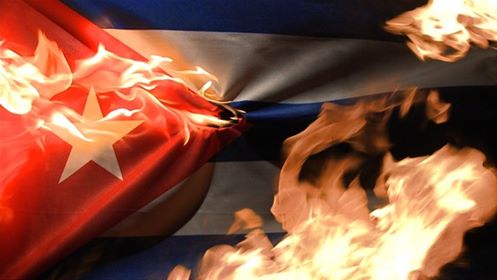An Artistic Performance Gives Cuba’s Flag Back its Symbolic Nature
By Lynn Cruz

HAVANA TIMES – It was May 1, 2017 when a Cuban, Daniel Llorente, emerged from out of the large crowd in Havana’s Revolution Square, waving a US flag. He had waved it before, when the first cruise ship from the US in 50 years, docked in Havana Bay.
I remember the expression that came to mind when I saw him was: “we’ve lost Cuba.” Recently, journalist Juan Orlando Perez analyzed the dissolution of the country, in the State’s hands, in his essay Nada somos ya, which was published in El Estornudo. Looking at this act from this perspective, we could say that we are in the face of the abyss.
Some of the questions I had back then were: why does a black man identify more with the US flag than the Cuban flag? I immediately began to make connections. It might have been a way to snub the fact that the subject of racism has been removed from the Cuban political agenda. If the Cuban Revolution really had done away with differences, and everyone was equal regardless of the color of their skin, why are there so few black people within the powerful elite, for example?
Many people also thought this was an annexationist act, others believed the man had lost his mind because in reprisal the Cuban government admitted him into a hospital for the mentally sick, when he was taken away. However, Llorente insisted that he would continue to wave the flag. Two years later, in 2019, the first images of the arrest of performance artist Luis Manuel Otero Alcantara appeared, for his work Se USA (catwalk), in which he paid tribute to Llorente.
Later on, Otero Alcantara opened this act up to every Cuban with the performance piece Le Drapeau. This time, it was about people taking a photo with the flag, but a Cuban flag, which is still in mourning and dark, as poet Bonifacio Byrne once said during colonial times. During that time, a flood of photos of our fellow Cubans were posted on Facebook walls, on Instagram, catching the bug to take part and assuming the act as an act of freedom, and not as prisoners of an ideology.
That’s to say, the artist that the Cuban government had arbitrarily detained, had stirred patriotic feelings within the Cuban people. He gave that piece of three-colored fabric its symbolic nature back. He had to sacrifice himself so that people would wake from their slumber and become aware that Cuba doesn’t belong to a group of military officers. That a country isn’t built by marginalizing its parts, but by bringing them together to live and work as an entire unit, paraphrasing Marti.
Lilianne Ruiz, a Cuban exile, said the following about this performance: “the flag in Luisma’s performance became a symbol of love for us. I can understand that a free translation of “love for the Homeland” is still loving it despite all of its shortcomings. Having all of the paths open to us amidst an overload of incentives and opportunities and in spite of this, not finding a taste for it, but to carry on waking up Cuba.”
Reading these words on my Facebook wall made me remember the importance of art. Leaving Cuba under extreme circumstances, like most people who leave this island, is a traumatic situation. When people face the unknown, they are alone a lot of the time, they have no other option but to hate the land that didn’t allow them to progress and grow.
Especially when you discover abroad that Fidel Castro’s politics were all one big lie. If Cubans speak about the flag on social media today, it’s because of artist Luis Manuel Otero Alcantara, who has been accused of insulting it, in his attempt to draw attention to just how much the Cuban nation has been trampled over.





